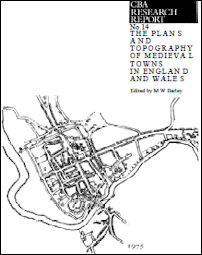CBA Research Reports
Council for British Archaeology, 2000. (updated 2020) https://doi.org/10.5284/1000332. How to cite using this DOI
Data copyright © Council for British Archaeology unless otherwise stated
This work is licensed under the ADS Terms of Use and Access.
Primary contact
Council for British Archaeology
92 Micklegate
York
YO1 6JX
UK
Tel: 01904 671417
Resource identifiers
- ADS Collection: 281
- DOI:https://doi.org/10.5284/1000332
- How to cite using this DOI
The plans and topography of medieval towns in England and Wales
M W Barley (editor)
CBA Research Report No 14 (1976)
ISBN 0 900312 33 5
Abstract

The editor introduces this volume of papers read at a symposium in November 1974 and outlines the recent history of urban archaeology in this country. D M Palliser (pp 1-7) surveys the use of documents, standing buildings and below-ground archaeology for urban topography. H Carter (7-19) selects geographical aspects such as the influence of topography on urban form and statistical measures for street systems and plot shapes. The evolution of pre-Conquest planned towns is Martin Biddle's subject (19-32) and of post-Conquest plantations, L A S Butler's (32-48). The natural growth of towns (e.g. through markets) is surveyed by Colin Platt (48-56), post-Conquest defences by M W Barley (57-71), and suburban growth by D J Keene (71-82). Summaries of the discussion following each paper are provided and further problems needing research are defined.
Contents
- Title pages
- Introduction by M W Barley (p v)
- Acknowledgments (p vi)
- Sources for Urban Topography: Documents, Buildings, and Archaeology by D M Palliser (p 1)
- The Town in its Setting: the Geographical Approach by H Carter (p 7)
- The Evolution of Towns: Planned Towns before 1066 by Martin Biddle (p 19)
- The Evolution of Towns: Planned Towns after 1066 by Lawrence Butler (p 32)
- The Evolution of Towns: Natural Growth by Colin Platt (p 48)
- Town Defences in England and Wales after 1066 by M W Barley (p 57)
- Suburban Growth by D J Keene (p 71)
- Further Research Projects (p 83)
- Bibliography (p 84)
- Index (p 89)
Download report
| The plans and topography of medieval towns in England and Wales (CBA Research Report 14) | 3 Mb |







